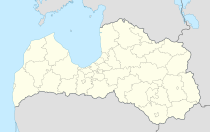Seda (Latvia)
| Seda (Latvia) ( German : Sedde) | ||
|---|---|---|
 |
|
|
| Basic data | ||
| State : |
|
|
| Landscape: | Livonia ( Latvian : Vidzeme ) | |
| Administrative district : | Strenču novads | |
| Coordinates : | 57 ° 39 ' N , 25 ° 45' E | |
| Residents : | 1,356 | |
| Area : | 2.03 km² | |
| Population density : | 668 inhabitants per km² | |
| Height : | 50 m | |
| City law: | since 1991 | |
| Website: | ||
| Post Code: | ||
| ISO code: | ||
| Culture House in Seda | ||
Seda (German: Sedde ) is a city in northern Latvia , which was built in the 1950s as a workers' settlement in a peat-mining area. In 2016 it had 1,356 inhabitants. It is named after the river Seda that flows through the urban area and flows into Lake Burtnieker .
history
The wetland "Seda" belonged to the Wolfarths Linde estate (today Lat. Jērcēni ). In 1938 a state stock company "Kūdra" (= peat ) was founded to exploit the peat deposits. Until 1954, however, there was only a single homestead in the forest and swamp area.
On August 5, 1954, the plan to build a peat factory with a workers' settlement was approved. For example, an area north of the Valga - Riga railway line was cleared and construction work started. The project was advertised as an All- Union Komsomol -Stoss building object, so that young workers from all parts of the Soviet Union registered. The workers' estate is an example of classicist architecture from the Stalin era. Due to the composition of the population of 4,000, Seda was a Russian-language island in northern Latvia. City rights were granted in 1991, although the population was already dwindling as a result of Latvian independence and the economic restructuring of Latvia. In 2006, 64% of the population were Russian and 17% Latvian. The remaining 19% are spread over 16 other nationalities. About half of all residents had Latvian citizenship. A third of all were retirees .
The privatized operating company is the largest peat producer in Latvia.
architecture
The city structure is very compact. The broad streets lined with birch and linden trees diverge in a star shape around a large central square. The architecture of the public buildings and houses in the Stalinist - Classicist style can not be found anywhere else on Latvian territory. Only on the outskirts are some of the multi-family houses otherwise common in communism . More recently, a shop has been converted into an Orthodox church . The hastily built, all yellowish buildings show traces of time and are half empty.
The Seda swamp
The 7582 hectare swamp area is crossed by a rail system for narrow-gauge railways . The locomotives are used to transport peat - tourists are not taken along. After half a century, the peat stocks are largely exhausted. The resulting wetlands are home to a species-rich fauna of partially protected animals and are important for migratory birds . Hundreds of northern swans gather here in spring and over a thousand wild geese in autumn . A large area in the heart of the swamp is still in a natural state, as all attempts to drain it have failed. Here tree roots were extracted from the swamp, some of which have been preserved for 3000 years. In autumn, the area is popular with collectors of blueberries and cranberries . Mushrooms also grow in the drier forests.
literature
- Hans Feldmann , Heinz von zur Mühlen (ed.): Baltic historical local dictionary, part 2: Latvia (southern Livonia and Courland). Böhlau, Cologne 1990, ISBN 3-412-06889-6 , pp. 571-572.
- Astrīda Iltnere (ed.): Latvijas Pagasti, Enciklopēdija. Preses Nams, Riga 2002, ISBN 9984-00-436-8 .
Web links
Individual evidence
- ↑ «Latvijas iedzīvotāju skaits pašvaldībās pagastu dalījumā"
- ↑ Hans Feldmann, Heinz von zur Mühlen (ed.): Baltic historical local dictionary, part 2: Latvia (southern Livland and Courland). Böhlau, Cologne 1990, p. 572.
- ↑ Latvian: "Vissavienības komjaunatnes triecienceltni" from www.strencunovads.lv

